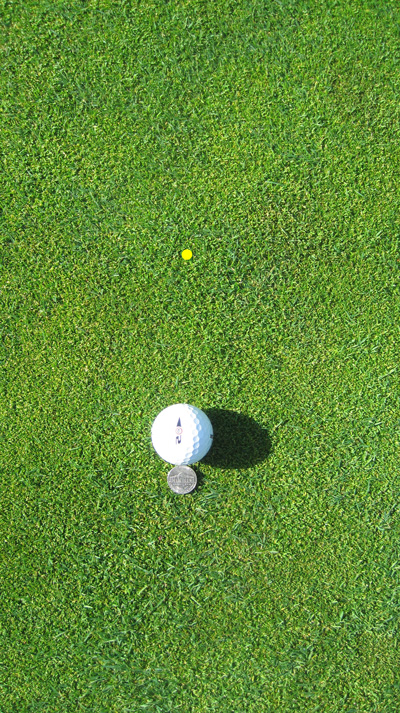Often I will try something out for a few weeks and if it seems to be a good thing I will write a post about it. This one is different. I discovered it in 2015. I didn’t want to let you know about it until I was sure it was sound.
It is.
The method, which I call Triangulated Approach Putting (TAP), will revolutionize your approach putting.
The commonest reason you three-putt is that you leave your first putt too far from the hole. You get the distance wrong. TAP lets you leave that first putt right beside the hole. It is almost scary how good you will get.
TAP is based on this axiom: For any length of putt, if the length of the putting stroke is the sole distance generator, there is one, and only one, length of stroke that will send the ball that distance.
TAP shows you how to find the length of that stroke. I’ll explain the theory first and then get into the fine points.
In the diagram below, you see a line from the ball to the hole. That is the baseline of a triangle. The spot marked apex is where you stand to find the length of stroke. An imaginary line on the ground from the ball to the apex is the eyeline. The line from the apex to the hole, not being a factor, and is not labeled. Distances are exaggerated for clarity.

The apex is located at a standard spot, half the length of the baseline and offset three paces to the left (to the right for left-handed golfers). These distances are adjustable.
Stand at the apex and set up your stance to face the baseline directly. Turn your head to look at the ball. The eyeline is an imaginary line on the ground that comes straight from the ball to you as you look at it. Swing your putter back and forth while looking at the ball. Make a stroke such that the clubhead intersects the eyeline . That length of stroke will send the ball the exact distance from where it now lies, to the hole.
That’s the theory. Here’s the practice.
(1) The length of the swing must be the sole distance generator. You cannot add any “hit” with your hands. That would be introducing another variable, which we do not want to do.
(2) You must hit the ball on the same spot of the putter’s face every time. The sweet spot is best. Erratic contact in this regard plays havoc with how much energy is imparted to the ball, and thus how far it goes.
(3) The speed of your putting stroke must be constant. Otherwise, you will unknowingly impart more or less energy to the ball, again affecting the distance it travels.
(4) The location of the apex is not fixed.
(a) If greens are slower or you are putting uphill, the apex must be more than halfway to the hole–point (A).
(b) If greens are faster or you are putting downhill, the apex must be less than halfway to the hole–point (B).
(c) Your putter can make a difference. If you are consistently leaving putts too long or too short, stand more or less than three paces from the baseline–closer to make putts go farther, or at more remove to make them travel shorter.
(5) An essential point is remembering the length of the stroke. After all, you have to walk over to the ball to hit the putt, and in that time you might forget. While at the apex, make several strokes that intersect the eyeline and pay attention to how that stroke feels to your body. There might be a slight stretching somewhere in your back, or your arms might brush against you in a certain way. When you get to the ball, recreate that sensation.
(6) Hit the ball with trust. TAP works if you let it.
Regarding the adjustments in (4), the more you practice TAP, the more accurate your adjustments will become.
Use TAP when distance is more important than line. How far from the hole that switch gets made is up to you, but ten feet is not too close.
I have tried this method on different practice greens, on different courses, and after I have adjusted to the conditions it always works.
You could take out all my posts from 2009 to date and nothing would be missing because you can read all of it somewhere else. I have just been adding emphasis or perhaps clarity.
But TAP is new. There is nothing remotely like it to be seen anywhere else. If you want to save strokes on the green starting almost overnight, here’s how. No kidding.






